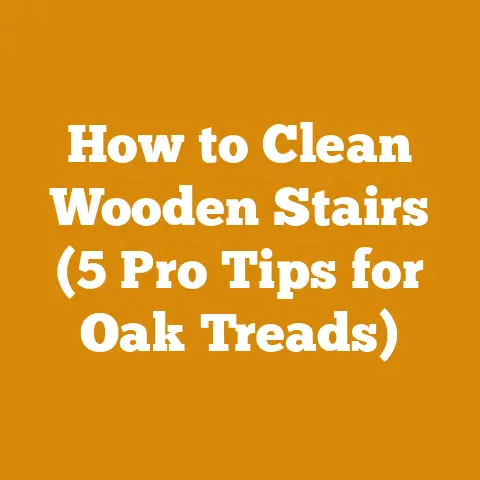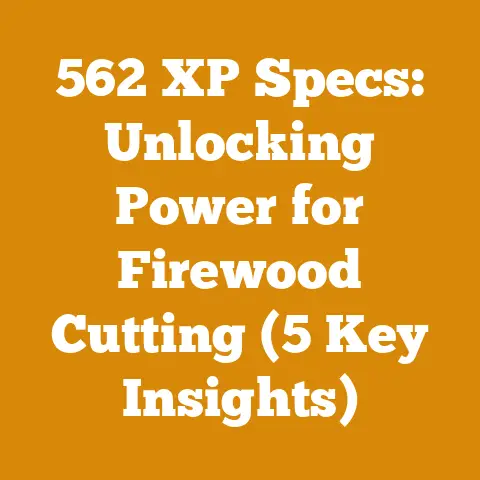Brick Around Wood Stove (5 Expert Tips for Optimal Heat)
Okay, let’s dive into the world of wood stoves and brickwork! While there are low-maintenance heating options out there, nothing quite compares to the cozy, radiant heat of a wood stove, especially when surrounded by a well-crafted brick surround. It’s a project that not only enhances the aesthetic appeal of your home but also significantly improves the efficiency and safety of your wood-burning appliance.
In this article, I’m going to share my expertise and insights on how to build a brick surround for your wood stove, focusing on maximizing heat retention and optimizing performance. I’ll guide you through the process step-by-step, offering practical tips, addressing common challenges, and providing the knowledge you need to achieve exceptional results. So, grab your tools, and let’s get started!
Key Takeaways:
- Improved Heat Retention: A brick surround acts as a thermal mass, absorbing and radiating heat long after the fire has died down.
- Enhanced Safety: The brick provides a non-combustible barrier, protecting your walls and reducing the risk of fire.
- Increased Efficiency: By reflecting heat back into the room, a brick surround can improve the overall heating efficiency of your wood stove.
- Aesthetic Appeal: A well-designed brick surround adds character and charm to your living space, creating a focal point that complements your home’s decor.
- DIY Project: Building a brick surround is a rewarding DIY project that can save you money and allow you to customize the look to your personal preferences.
Brick Around Wood Stove: 5 Expert Tips for Optimal Heat
Why Brick Around Your Wood Stove? The Science of Radiant Heat
Before we get our hands dirty, let’s understand the why behind bricking a wood stove. It’s not just about aesthetics (though that’s a definite plus!). It’s about harnessing the power of radiant heat and thermal mass.
Think of it this way: your wood stove is a concentrated source of heat. Without a surround, much of that heat rises quickly to the ceiling, leaving the lower areas of your room cooler. A brick surround acts as a thermal battery. The brick absorbs the heat from the stove, storing it and then slowly releasing it back into the room as radiant heat.
Radiant heat is a game-changer. Unlike convection heat (from forced-air furnaces), which heats the air, radiant heat directly warms objects and people. This results in a more even, comfortable heat distribution and a more efficient use of your fuel.
Data Point: Studies have shown that a properly designed thermal mass surround can increase the heating efficiency of a wood stove by 10-20%. That translates to less wood consumed and more consistent warmth.
My Experience: I remember one winter where I was constantly feeding my old wood stove, trying to keep the house warm. After installing a simple brick surround, I was amazed at how much longer the heat lasted after the fire died down. It was like the bricks were giving back the heat they had soaked up all day.
Tip #1: Choosing the Right Bricks: Material Matters
Not all bricks are created equal! For a wood stove surround, you need bricks that can withstand high temperatures and prolonged exposure to heat.
Here’s a breakdown of the best options:
-
Fire Brick (Refractory Brick): This is the gold standard. Fire brick is specifically designed to withstand extreme temperatures (up to 2,000°F or 1,093°C). They are dense and have excellent heat retention properties. Firebricks are the best choice for the firebox itself, and can also be used for the surround.
-
Clay Brick (Common Brick): Clay bricks are a more affordable option and are suitable for the surround, but not for direct contact with the fire. They are more porous than fire brick and will absorb more moisture. Make sure they are rated for high-temperature use.
-
Paver Brick: Paver bricks are designed for outdoor use and are typically more durable than clay bricks. They can also be used for a wood stove surround, but make sure they are rated for high-temperature use.
What to Avoid:
- Concrete Brick: Concrete bricks are not suitable for high-temperature applications. They can crack and crumble under extreme heat.
- Used Bricks of Unknown Origin: Unless you know the origin and composition of the bricks, it’s best to avoid using them. They may contain harmful chemicals or not be able to withstand the heat.
Expert Insight: “When choosing bricks for your wood stove surround, always prioritize quality over cost,” says Bob Vila, a renowned home improvement expert. “Investing in high-quality bricks will ensure the longevity and safety of your installation.”
Tip: Consider the aesthetic appeal of the bricks as well. Do you want a rustic look with reclaimed bricks, or a more modern look with smooth, uniform bricks? This is the time to get creative and choose bricks that complement your home’s style.
Tip #2: Planning and Design: Measure Twice, Cut Once (and Brick Smart!)
Before you start laying bricks, you need a solid plan. This involves measuring your space, designing the surround, and calculating the amount of materials you’ll need.
Here’s a step-by-step guide:
-
Measure the Area: Carefully measure the area around your wood stove where you plan to build the surround. Consider the clearances required by your stove manufacturer and local building codes. These clearances are crucial for safety and prevent the risk of fire.
-
Design the Surround: Sketch out your design on paper or use a computer-aided design (CAD) program. Consider the height, width, and depth of the surround, as well as any decorative elements you want to include.
-
Calculate Material Needs: Once you have your design, calculate the number of bricks, mortar, and other materials you’ll need. Add a buffer of 10-15% to account for waste.
-
Foundation Preparation: The base is crucial. A solid, level foundation is essential for a stable brick surround. If you have a concrete floor, you can build directly on top of it. If you have a wood floor, you’ll need to create a non-combustible base using cement board or a similar material.
-
Ventilation Considerations: Ensure adequate ventilation around the wood stove. Do not completely enclose the stove, as this can lead to overheating and potential hazards. Leave gaps at the top and bottom of the surround to allow for airflow.
Data Point: According to the National Fire Protection Association (NFPA), improper clearances around wood stoves are a leading cause of residential fires. Always adhere to the manufacturer’s specifications and local building codes.
My Experience: I once helped a friend build a brick surround without properly accounting for ventilation. The stove overheated, and we had to dismantle part of the surround to improve airflow. It was a valuable lesson in the importance of planning and attention to detail.
Tip #3: Mortar Matters: Choosing and Mixing for the Long Haul
The mortar is the glue that holds your brick surround together. Choosing the right mortar and mixing it properly is crucial for a strong, durable, and heat-resistant structure.
Here’s what you need to know:
- Type N Mortar: Type N mortar is a good general-purpose mortar that is suitable for most brickwork applications. It is a balanced mix of Portland cement, lime, and sand.
- Type S Mortar: Type S mortar is a stronger mortar that is recommended for applications where high strength is required. It is a mix of Portland cement, lime, and sand, but with a higher proportion of cement.
- Refractory Mortar (Fire Clay Mortar): Refractory mortar is specifically designed for high-temperature applications. It is made from fire clay and is able to withstand extreme heat without cracking or crumbling. Use this for firebricks.
Mixing Mortar:
- Use a Mortar Mixer: For larger projects, a mortar mixer is a worthwhile investment. It will save you time and effort and ensure a consistent mix.
- Mix by Hand: If you’re mixing by hand, use a wheelbarrow or a large tub. Add the dry ingredients first, then gradually add water until you reach a smooth, workable consistency.
- Consistency is Key: The mortar should be thick enough to hold its shape but still be pliable enough to spread easily.
- Let it Slake: After mixing, let the mortar sit for 10-15 minutes to allow the lime to slake (hydrate). This will improve its workability and bond strength.
Expert Insight: “The key to a strong mortar joint is proper mixing and application,” says Mike Holmes, a trusted contractor and TV personality. “Don’t skimp on the mixing process, and make sure you apply the mortar evenly and thoroughly.”
Tip: Always wear gloves and eye protection when working with mortar. Mortar can be irritating to the skin and eyes.
Tip #4: Laying the Bricks: A Step-by-Step Guide to a Solid Surround
Now for the fun part: laying the bricks! This requires patience, precision, and a good eye for detail.
Here’s a step-by-step guide:
-
Start with a Level Base: Ensure that your foundation is perfectly level. Use a level to check the base in all directions.
-
Lay the First Course: Apply a bed of mortar to the foundation and lay the first course of bricks. Use a level to ensure that the bricks are perfectly aligned.
-
Apply Mortar to the Bricks: Apply mortar to the ends of each brick before placing it in position. This will create a strong bond between the bricks.
-
Use Spacers: Use spacers to maintain consistent joint widths between the bricks. This will create a uniform and professional look.
-
Check for Level and Plumb: Regularly check for level and plumb as you lay the bricks. Use a level and a plumb bob to ensure that the surround is straight and square.
-
Tooling the Joints: Once the mortar has partially set, use a brick jointer to tool the joints. This will compress the mortar and create a watertight seal.
-
Clean Up: Regularly clean up any excess mortar from the brick surfaces. This will prevent staining and make the finished product look more professional.
Different Brick Patterns:
- Running Bond: The simplest and most common pattern, where each brick is offset by half a brick length.
- Stack Bond: Bricks are stacked directly on top of each other, creating a clean, modern look.
- Herringbone: Bricks are laid in a zigzag pattern, creating a visually appealing texture.
My Experience: I remember my first bricklaying project. I was so eager to get started that I rushed the process and ended up with uneven joints and crooked lines. It was a humbling experience, but it taught me the importance of patience and attention to detail.
Tip: Don’t be afraid to take breaks. Bricklaying can be physically demanding, so take regular breaks to rest and stretch.
Tip #5: Finishing Touches: Sealing, Detailing, and Safety Checks
Once the brick surround is complete, it’s time to add the finishing touches. This includes sealing the brick, adding decorative elements, and performing a thorough safety check.
Here’s what you need to do:
-
Sealing the Brick: Sealing the brick will protect it from moisture and stains. Use a breathable sealant that is specifically designed for brick.
-
Adding Decorative Elements: Consider adding decorative elements such as a mantel, corbels, or a brick arch. These elements can enhance the aesthetic appeal of your surround.
-
Checking Clearances: Double-check the clearances between the wood stove and the surround. Ensure that they meet the manufacturer’s specifications and local building codes.
-
Inspecting for Cracks: Carefully inspect the brickwork for any cracks or gaps. Repair any imperfections with mortar.
-
First Fire: Before using your wood stove, perform a small test fire to allow the mortar to cure completely.
Safety First:
- Carbon Monoxide Detector: Install a carbon monoxide detector in the room with your wood stove. Carbon monoxide is a colorless, odorless gas that can be deadly.
- Smoke Detector: Ensure that your smoke detector is in good working order.
- Fire Extinguisher: Keep a fire extinguisher nearby in case of emergencies.
Expert Insight: “Safety should always be your top priority when working with wood stoves,” says a certified chimney sweep. “Regular inspections and maintenance are essential for preventing fires and ensuring the safe operation of your appliance.”
Tip: Consider hiring a professional chimney sweep to inspect your wood stove and chimney annually. This will help identify any potential problems and ensure that your appliance is operating safely.
Advanced Considerations for Wood Stove Brick Surrounds
Beyond the basics, let’s explore some advanced considerations that can take your brick surround to the next level. These insights are geared towards those looking to maximize heat output, efficiency, and aesthetic appeal.
Thermal Mass Optimization: Beyond a Simple Surround
While any brick surround will improve heat retention, you can optimize the thermal mass for even greater benefits.
-
Thickness Matters: The thicker the brick surround, the more heat it can absorb and store. Consider building a thicker surround, especially if you have a large room to heat.
-
Material Combinations: Experiment with different materials to enhance thermal mass. For example, you could incorporate a layer of concrete behind the brick to increase heat storage capacity.
-
Airflow Design: Carefully consider the airflow around the stove and through the surround. Strategically placed vents can help circulate heat more effectively.
Incorporating a Baking Oven: A Rustic Touch
For the truly ambitious, consider incorporating a small baking oven into your brick surround. This is a fantastic way to utilize the heat from your wood stove for cooking.
-
Design Considerations: The oven should be located near the firebox to maximize heat transfer. Use fire brick for the oven walls and floor to withstand high temperatures.
-
Temperature Control: Install a thermometer in the oven to monitor the temperature. Use a damper to control the airflow and regulate the heat.
-
Safety Precautions: Ensure that the oven is properly insulated to prevent burns.
Water Heating Integration: A Sustainable Solution
Another advanced option is to integrate a water heating system into your brick surround. This can provide you with hot water for domestic use, reducing your reliance on traditional energy sources.
-
Heat Exchanger: Install a heat exchanger in the firebox or chimney to capture waste heat.
-
Storage Tank: Connect the heat exchanger to a storage tank to store the heated water.
-
Plumbing Connections: Connect the storage tank to your plumbing system to provide hot water to your faucets and showers.
Case Study: A homeowner in rural Vermont built a brick surround with a built-in baking oven and a water heating system. The system provides hot water and supplemental heat for their home, reducing their energy bills by 50%.
Troubleshooting Common Problems
Even with careful planning and execution, you may encounter some challenges during the bricklaying process. Here are some common problems and how to solve them:
-
Mortar Cracking: Cracking mortar is often caused by improper mixing or drying too quickly. Ensure that you mix the mortar according to the manufacturer’s instructions and keep it moist while it cures.
-
Bricks Shifting: Shifting bricks can be caused by an uneven foundation or insufficient mortar. Ensure that your foundation is level and use plenty of mortar to create a strong bond.
-
Efflorescence: Efflorescence is a white, powdery deposit that can appear on the surface of the brick. It is caused by mineral salts leaching out of the mortar. Clean it off with a stiff brush and a solution of water and vinegar.
-
Smoke Leaks: Smoke leaks can be caused by gaps in the brickwork or a faulty chimney. Inspect the surround for any gaps and seal them with mortar. Have your chimney inspected by a professional to ensure that it is in good working order.
The Economics of a Brick Surround
Let’s talk about the financial side of things. A brick surround is an investment, but it can pay off in the long run through increased heating efficiency and reduced fuel consumption.
Here’s a breakdown of the costs:
- Materials: The cost of bricks, mortar, and other materials will vary depending on the type of bricks you choose and the size of your surround.
- Tools: You may need to purchase some specialized tools, such as a brick saw, a mortar mixer, and a brick jointer.
- Labor: If you hire a professional to build the surround, labor costs can be significant.
Potential Savings:
- Reduced Fuel Consumption: A brick surround can improve the heating efficiency of your wood stove by 10-20%, which can translate to significant savings on your fuel bill.
- Increased Home Value: A well-designed brick surround can add value to your home.
Return on Investment:
The return on investment (ROI) of a brick surround will depend on your individual circumstances. However, in general, you can expect to recoup your investment within a few years through reduced fuel costs and increased home value.
Staying Compliant: Codes and Regulations
Before you start building your brick surround, it’s essential to be aware of local building codes and regulations. These codes are in place to ensure the safety of your installation and prevent fires.
Here are some key considerations:
- Clearances: Building codes specify the minimum clearances required between the wood stove and combustible materials. These clearances vary depending on the type of stove and the type of materials used in the surround.
- Foundation Requirements: Building codes may specify requirements for the foundation of the surround.
- Permits: In many areas, you will need to obtain a building permit before you can start construction.
Expert Advice: “Always check with your local building department before starting any construction project,” says a building inspector. “This will ensure that you are in compliance with all applicable codes and regulations.”
The Future of Wood Heating: Sustainability and Innovation
As we look to the future, wood heating is becoming increasingly important as a sustainable and renewable energy source. New technologies and innovations are making wood stoves more efficient, cleaner-burning, and easier to use.
- High-Efficiency Stoves: Modern wood stoves are designed to burn wood more efficiently and produce less smoke.
- Pellet Stoves: Pellet stoves burn wood pellets, which are a renewable and sustainable fuel source.
- Automated Systems: Some wood stoves are equipped with automated systems that control the airflow and fuel feed, making them easier to use and more efficient.
My Vision: I believe that wood heating will continue to play a vital role in our energy future. By embracing sustainable practices and innovative technologies, we can harness the power of wood to heat our homes and reduce our reliance on fossil fuels.
Conclusion: Embrace the Warmth
Building a brick surround for your wood stove is a rewarding project that can enhance the beauty, efficiency, and safety of your home. By following the expert tips and guidelines in this article, you can create a stunning and functional addition to your living space.
So, gather your tools, choose your bricks, and get ready to embrace the warmth of a wood stove surrounded by the timeless beauty of brick. Remember to prioritize safety, plan carefully, and take your time. The result will be a cozy and inviting space that you and your family will enjoy for years to come.
Now that you are armed with the knowledge and inspiration, it’s time to take action. Start planning your brick surround today, and experience the joy of a warm, inviting home heated by the power of wood. Happy bricklaying!






